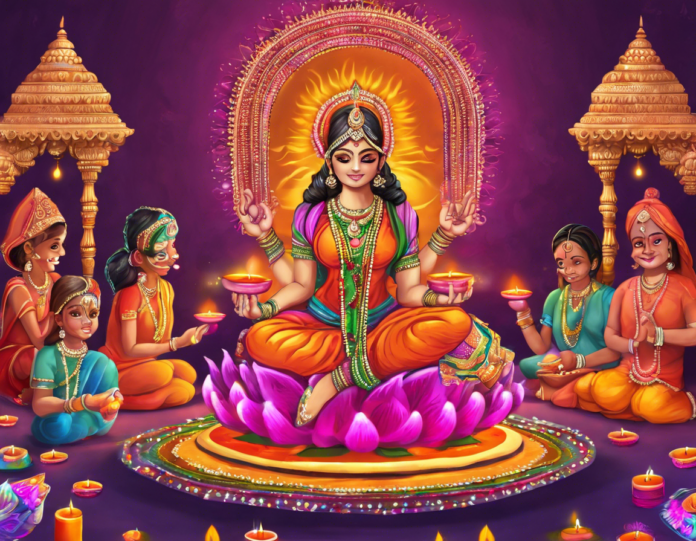Diwali, also known as the Festival of Lights, is one of the most significant and popular festivals celebrated in India and by Hindus around the world. It symbolizes the victory of light over darkness and good over evil. The festival typically lasts for five days, with the third day being the main day of celebration. Central to Diwali festivities is the Diwali Puja, a ritual of worship that is conducted by families seeking blessings from the gods for prosperity, wealth, and overall well-being. In this comprehensive guide, we will delve into the significance of Diwali Puja, the auspicious timings, and the essential rituals involved in performing the puja.
Significance of Diwali Puja
The Diwali Puja holds immense significance in Hindu culture and tradition. It is believed that during Diwali, the Goddess Lakshmi, the goddess of wealth and prosperity, visits homes that are clean and well-lit and blesses the inhabitants with wealth and happiness. Hence, performing the Diwali Puja is a way of welcoming the goddess into one’s home and seeking her blessings. Additionally, the puja is also dedicated to Lord Ganesha, the remover of obstacles, to ensure a smooth and successful life ahead.
Auspicious Timings for Diwali Puja
Diwali Puja is performed during the evening hours when the atmosphere is charged with festive fervor and positive energy. The auspicious timing for the puja is determined by the Lakshmi Puja Muhurat which is calculated based on the configuration of planets and alignment of stars. The ideal timing for Diwali Puja varies each year, and it is essential to consult a Hindu religious calendar or a priest for the specific timings. However, generally, the puja is performed during the Pradosh Kaal, which is the time just after sunset.
Essential Rituals of Diwali Puja
Preparing for the Puja
-
Cleaning the House: Before the puja, it is customary to clean and decorate the house to welcome the goddess. A clean and well-lit house is believed to attract the blessings of Goddess Lakshmi.
-
Setting Up the Puja Area: A small altar or a designated area is set up in the house where the idols of Goddess Lakshmi and Lord Ganesha will be placed. The area is decorated with flowers, rangoli (colored powders), and lights.
Diwali Puja Rituals
-
Ganesh Puja: The puja begins with worshipping Lord Ganesha, the remover of obstacles. Offerings of durva grass, haldi (turmeric), kumkum (vermilion), and modaks (a type of sweet) are made to seek his blessings.
-
Lakshmi Puja: Following the Ganesh Puja, the main ritual of worshipping Goddess Lakshmi takes place. Diyas (oil lamps) are lit, and flowers, incense sticks, and sweets are offered to the goddess. Mantras dedicated to Goddess Lakshmi are chanted during the puja.
-
Offerings: Sweets, fruits, betel leaves, and a silver coin are offered to Goddess Lakshmi as part of the ritual. It is believed that these offerings please the goddess and in turn, bring prosperity to the household.
-
Aarti: The puja concludes with the singing of arti offerings, where a plate with a lit lamp or multiple lamps is ritually rotated in front of the deities, accompanied by singing devotional songs.
Exchange of Gifts
A significant part of Diwali celebrations is the exchange of gifts as a symbol of love and goodwill. Friends and family members exchange gifts, sweets, and diwali hampers to express their affection and strengthen bonds.
Frequently Asked Questions (FAQs)
- What is the significance of lighting diyas during Diwali Puja?
-
Lighting diyas symbolizes the victory of light over darkness, good over evil, and knowledge over ignorance. It is believed to ward off negative energies and bring positivity into the home.
-
Can I perform Diwali Puja without a priest?
-
Yes, Diwali Puja can be performed by individuals or families without a priest. There are guides and online resources available to help you through the rituals.
-
What materials are needed for Diwali Puja?
-
Materials required for Diwali Puja include idols of Goddess Lakshmi and Lord Ganesha, diyas, incense sticks, flowers, fruits, sweets, haldi, kumkum, betel leaves, and a silver coin.
-
Can Diwali Puja be performed at any time during the day?
-
It is recommended to perform Diwali Puja during the Pradosh Kaal just after sunset. Performing the puja during this auspicious time is believed to attract the blessings of the deities.
-
What is the significance of rangoli during Diwali Puja?
- Rangoli is believed to welcome Goddess Lakshmi into the home, as the intricate designs and vibrant colors are said to attract her presence and blessings.
In conclusion, Diwali Puja is a sacred and joyous occasion that brings families together to seek the blessings of Goddess Lakshmi and Lord Ganesha for prosperity and happiness. By following the prescribed rituals and performing the puja with devotion and sincerity, one can invite good fortune into their lives and homes during this auspicious festival of Diwali.









